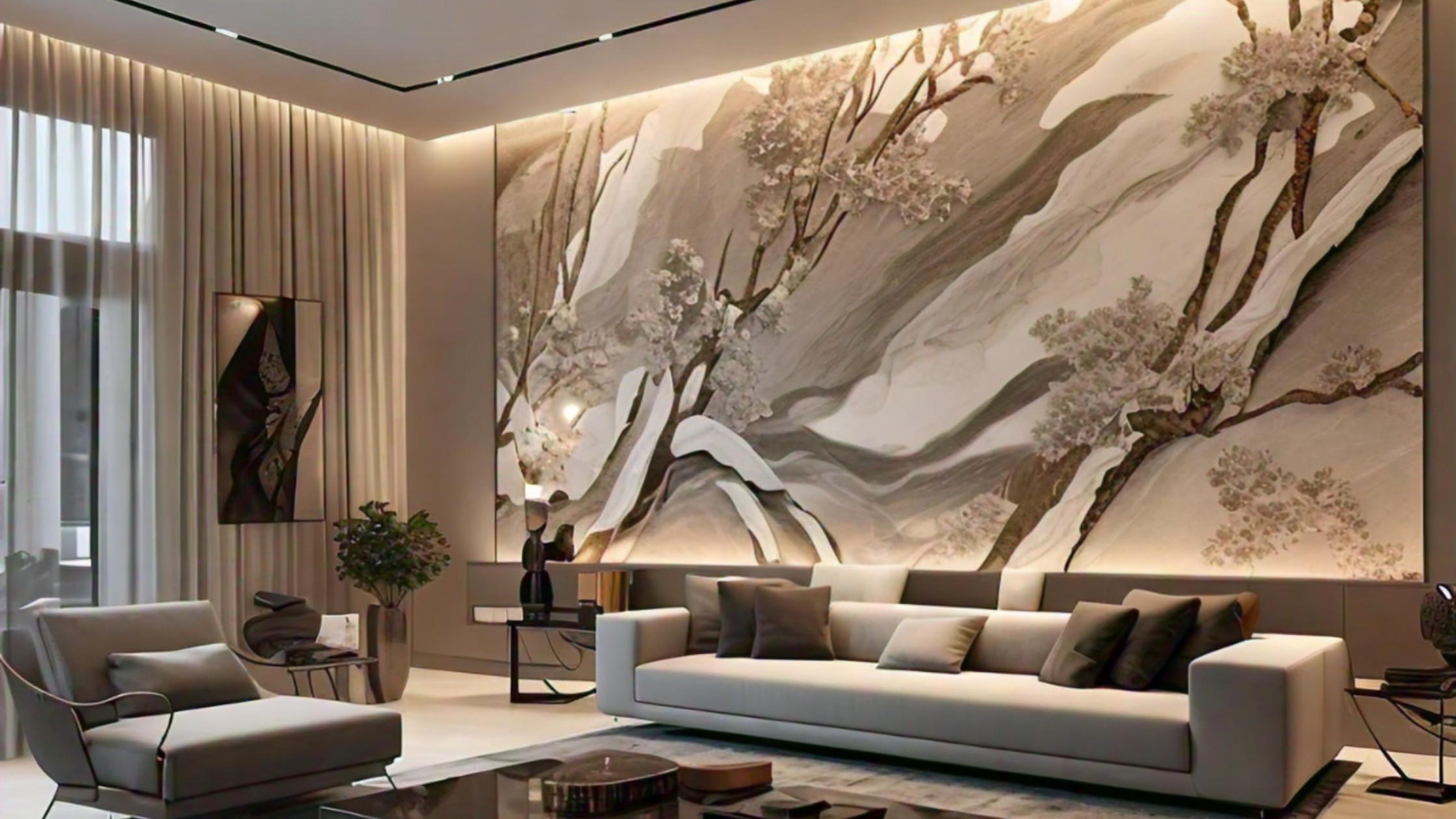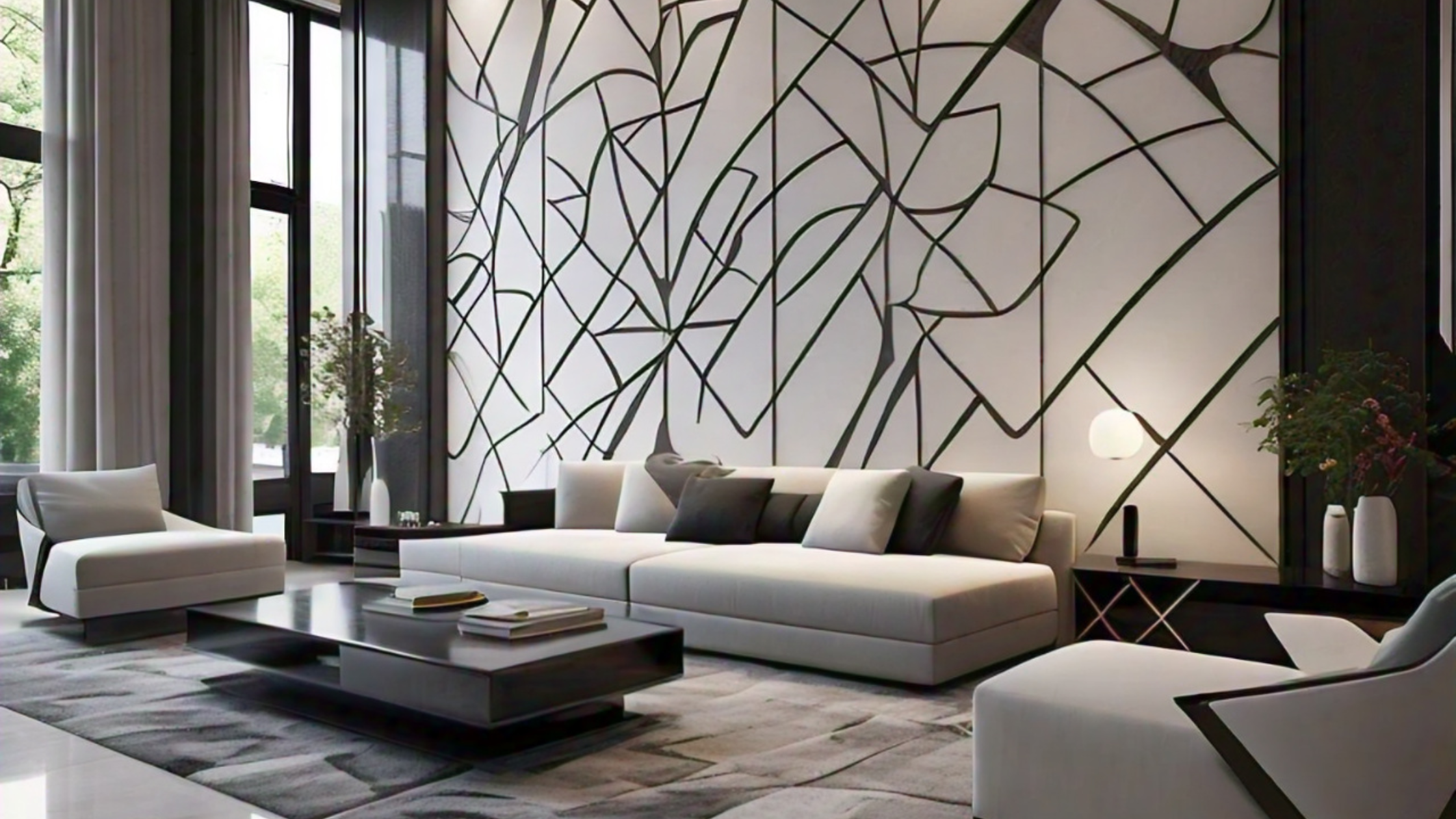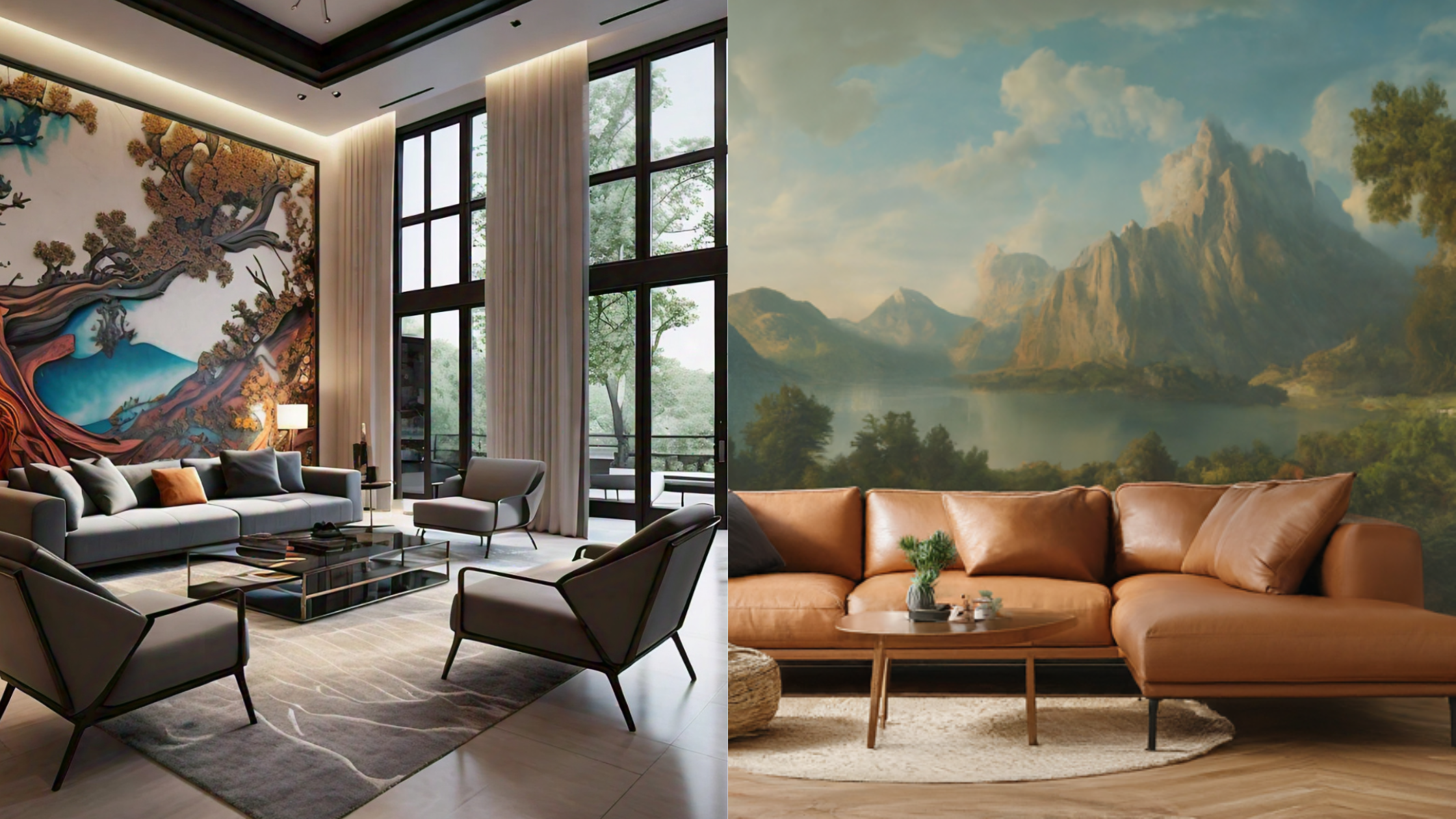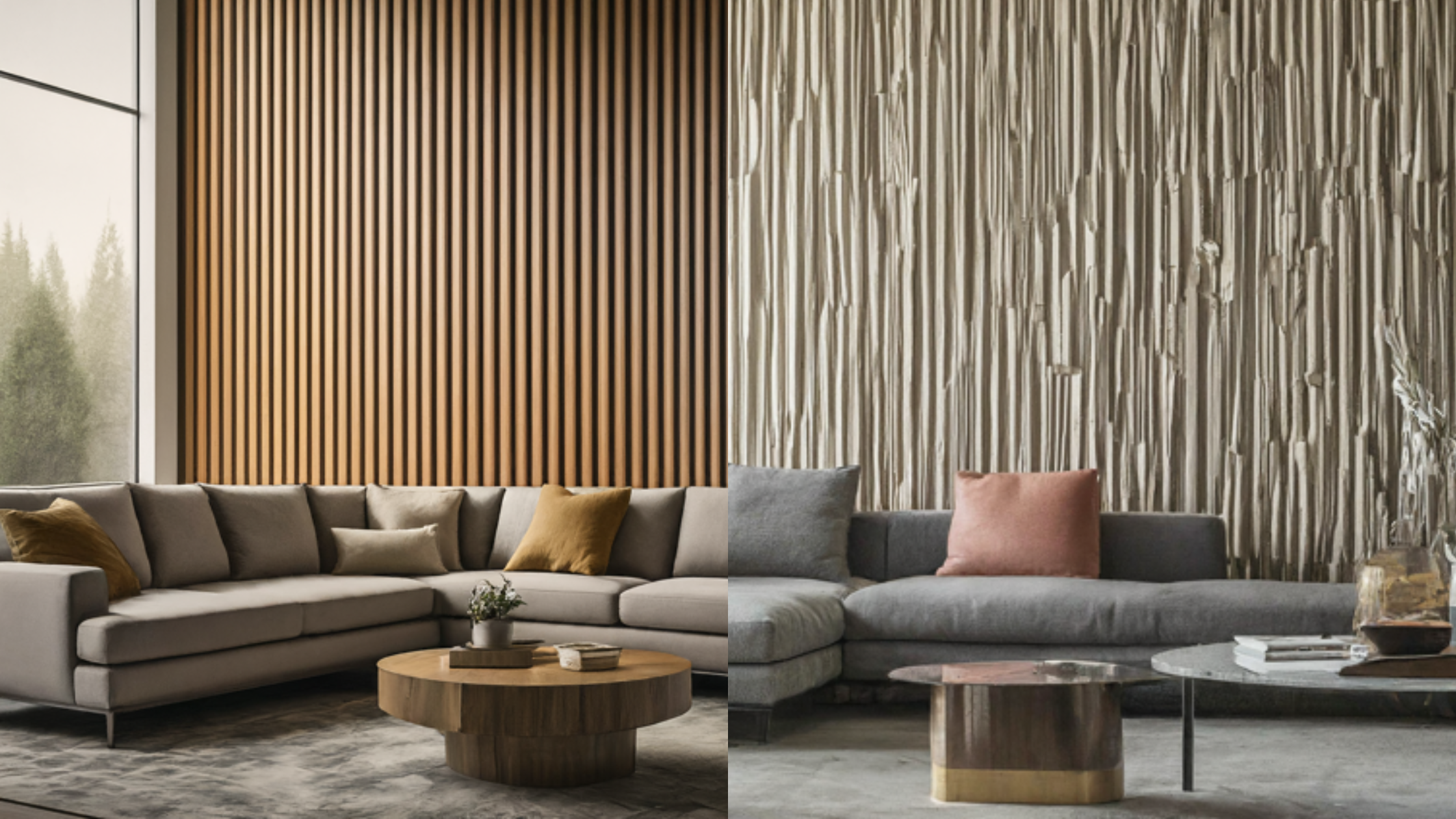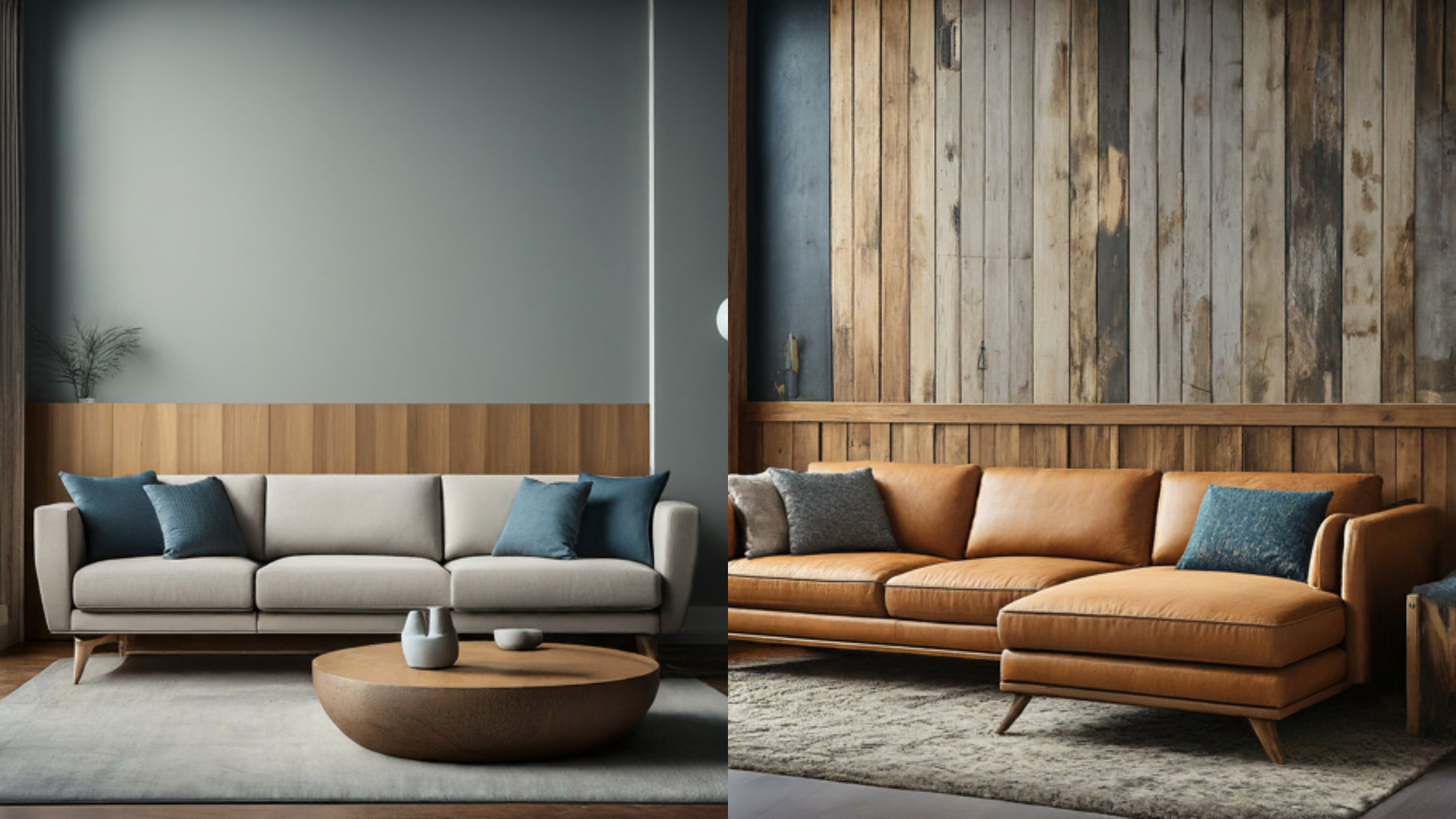Making a room stand out is one of the most important aspects of good interior design. A feature wall is one of the best ways to achieve this. A feature wall is a single wall within a room that is designed to stand out and attract attention. Unlike the surrounding walls, a feature wall is adorned with different colours, materials, or patterns, creating a striking visual contrast. This design technique is used to highlight a particular area of the room, such as a fireplace, bed, or artwork, turning it into the room’s focal point.
Benefits of Incorporating a Feature Wall in Your Home Decor
Feature walls offer numerous benefits, making them a popular choice for homeowners and designers alike:
Visual Interest
A feature wall adds visual interest and breaks the monotony of a room, making it more engaging and dynamic.
Focal Point
By drawing attention to a specific area, a feature wall creates a focal point that anchors the room’s design.
Personal Expression
Feature walls provide an opportunity to express your personality and style through unique colours, patterns, and textures.
Room Transformation
A well-designed feature wall can change the perception of a room’s size and shape, making small spaces appear larger and adding depth to flat walls.
Cost-Effective Makeover
Updating a single wall is a cost-effective way to refresh a room’s look without undertaking a full-scale renovation.
Materials and Textures
Paint and Colours
Paint is one of the simplest and most versatile materials for creating a feature wall. You can use bold, contrasting colours or subtle, complementary shades to make a statement.
Wallpaper
Wallpaper offers endless patterns, textures, and designs, from floral prints to geometric shapes and everything in between.
Wood Panelling
Wood panelling can bring warmth and a natural feel to your space, with options ranging from rustic reclaimed wood to sleek, modern panels.
Stone and Brick
Stone and brick feature walls create a rugged, earthy look that adds character and texture to a room.
Metal and Glass
Metal and glass feature walls offer a sleek, modern look, ideal for contemporary interiors.
How to Choose the Right Material Based on Your Home Decor
Selecting the right material for your feature wall depends on several factors:
Room Style: Match the material with your interior design style. For example, wood and stone suit rustic designs, while metal and glass fit modern spaces.
Functionality: Consider the room’s function and traffic. Durable materials like brick and stone work well in high-traffic areas, while delicate wallpapers might be better in less-used rooms.
Budget: Assess your budget and choose materials that fit within it. Paint and wallpaper are more affordable options, while stone and metal can be pricier.
Maintenance: Think about the maintenance requirements of each material. Easy-to-clean surfaces like metal and glass might be ideal for kitchens, while wood may need more upkeep.
By carefully considering these points, you can select the perfect material to create a stunning feature wall that enhances your home’s decor.
Accent Wall Designs to Elevate Your Living Space
Geometric Patterns
Geometric patterns are a modern and visually striking choice for accent walls. These designs can range from simple stripes and chevrons to complex shapes like hexagons and diamonds. Geometric patterns can be painted directly onto the wall or created using wallpaper or decals. They work particularly well in contemporary and minimalist spaces, adding a dynamic and structured aesthetic. When using geometric patterns, it’s essential to maintain balance in the room by keeping the rest of the decor relatively simple and cohesive.
Mural and Artwork
Murals and artwork transform an accent wall into a large canvas, creating a captivating focal point. Murals can depict anything from nature scenes and cityscapes to abstract art and custom designs. Hand-painted murals offer a personalised touch, while wallpaper murals provide a quicker, yet equally impactful solution. Incorporating murals or large-scale artwork allows you to express creativity and make a bold statement. To match this design with your interior, ensure that the colours and themes of the mural complement the room’s overall decor.
Textured and 3D Panels
Textured and 3D panels add depth and tactile interest to an accent wall. Options include wood slats, metal tiles, and moulded wall panels that create patterns and reliefs. These designs can introduce a sense of luxury and sophistication, making them ideal for living rooms, bedrooms, and feature walls in foyers. Textured walls work best in rooms with ample lighting, as shadows play an essential role in highlighting the depth and contours of the panels. Balance textured walls with smooth, understated furnishings to avoid overwhelming the space.
Natural Elements
Incorporating natural elements like wood and stone can bring warmth and an organic feel to your interiors. Wooden accent walls can range from rustic reclaimed wood to sleek, polished panels, fitting various design styles. Stone walls, whether real or faux, add a rugged and timeless appeal. Natural materials work well in both rustic and modern settings, depending on how they are integrated. For example, a stone wall can enhance a cosy, rustic living room or add a natural contrast to a sleek, modern kitchen.
Bold and Vibrant Colours
Using bold and vibrant colours on an accent wall can dramatically change the mood and perception of a room. Colours like deep blue, rich emerald, bright yellow, or striking red can energise a space and create a focal point. When choosing bold colours, it’s crucial to ensure they harmonise with the room’s existing colour palette. Complementary or analogous colours can create a pleasing visual balance, while too many contrasting colours may clash.
How to Match Accent Wall Designs with Your Interiors
Assess the Colour Scheme
The colour scheme of a room is fundamental in determining the appropriate design for an accent wall. Start by examining the primary and secondary colours used in your space. Your accent wall should harmonise with these colours to create a cohesive look. For example, if your room features a neutral palette with whites and greys, a bold, contrasting colour like navy blue or emerald green can make a striking yet complementary statement. Alternatively, if your room already has multiple colours, choose a shade that ties them together rather than introducing a new one.
Consider the Furniture
Furniture plays a significant role in defining the room’s style and should be considered when designing an accent wall. The materials, colours, and styles of your furniture can guide your choice of accent wall design. For example, in a room with modern, sleek furniture, a geometric pattern or a metallic accent wall would enhance the contemporary feel. Conversely, in a room with rustic wooden furniture, a wood-panelled or stone feature wall would complement the existing decor. Ensure that the accent wall does not clash with the furniture but instead enhances its appeal.
Evaluate the Overall Style
The overall style of the room should influence your choice of accent wall design. Different interior styles call for different types of accent walls.
Modern Style: Clean lines, minimalism, and bold colours or geometric patterns work well.
Rustic Style: Natural materials like wood and stone, and earthy tones are ideal.
Industrial Style: Exposed brick, metal panels, and raw textures complement this style.
Traditional Style: Elegant wallpaper patterns, classic murals, and rich colours enhance traditional decor.
Matching the accent wall to the room’s style ensures that it feels integrated and purposeful.
Consider the Room’s Function
The function of the room is another crucial factor in choosing an accent wall design. Different rooms serve different purposes and therefore require different atmospheres:
Bedrooms: Calming and serene designs are best for bedrooms. Soft, pastel colours, gentle murals, or subtle textured walls can create a relaxing environment.
Living Rooms: This is a space for socialising and entertaining, so a vibrant, bold-coloured wall, a dramatic mural, or a dynamic geometric pattern can energise the space.
Home Offices: For a productive and inspiring environment, consider accent walls with stimulating colours like blues or greens, or opt for a sophisticated textured panel.
Dining Areas: Create a warm and inviting atmosphere with rich, deep colours or elegant wallpapers.
Enhance, Don’t Compete
Your accent wall should enhance the room’s existing elements, not compete with them. It’s essential to strike a balance where the accent wall draws attention without overshadowing the room’s decor. For instance, in a room with a lot of intricate decor, a simpler accent wall design might be more appropriate. Conversely, in a minimalist space, a more elaborate or bold accent wall can serve as a focal point without overwhelming the overall aesthetic.
By carefully considering these factors, you can ensure that your accent wall design complements and enhances your interior, creating a harmonious and visually appealing space.
Use these Creative Concepts for Your Interiors
What Makes a Wall a ‘Statement Wall’?
A statement wall goes beyond being an accent wall by becoming a focal point that captures attention and adds a unique character to a room. Unlike accent walls that might use a different paint colour or texture, statement walls incorporate creative and bold elements that define the space. They are designed to make a lasting impression and often serve as the room’s main attraction. A statement wall can transform an ordinary room into an extraordinary space, reflecting the homeowner’s personality and style.
Gallery Walls
Gallery walls are an excellent way to personalise a space with art, photographs, and memorabilia. By arranging a curated collection of frames in various sizes and styles, you can create a visually engaging and meaningful display. To achieve a cohesive look, consider using frames with a common colour scheme or theme. Gallery walls work well in living rooms, hallways, and home offices, allowing you to showcase your creativity and cherished memories.
Chalkboard Walls
Chalkboard walls bring a playful and functional element to any room. They are perfect for kitchens, children’s rooms, or home offices where they can be used for writing notes, drawing, or creating art. A chalkboard wall can be easily created using chalkboard paint, which allows you to change the design as often as you like. This type of statement wall encourages interaction and creativity, making it a dynamic and engaging feature.
Fabric and Tapestry Walls
Using fabric or tapestries to create a statement wall adds texture, colour, and warmth to a room. Large tapestries with intricate designs or vibrant colours can become a dramatic backdrop in a living room or bedroom. Alternatively, fabric panels can be used to cover an entire wall, providing a soft and luxurious feel. This approach can also help with sound insulation and is relatively easy to change if you want a new look.
Lighting and LED Walls
Lighting can play a crucial role in creating a statement wall. LED walls, for example, use programmable lights to create dynamic patterns and colours, adding a modern and futuristic touch to a room. These walls can be customised to change colours and patterns, providing a versatile and eye-catching feature. Additionally, strategically placed lighting, such as wall sconces or backlit panels, can highlight textures or artwork, making the wall stand out even more. Lighting and LED walls are perfect for living rooms, media rooms, and entertainment areas where they can create a dramatic ambience.
In this way, statement walls can enhance your home décor dramatically and make your home unique to you.
Feature walls are a versatile and impactful element in interior design, allowing you to personalise your space and create stunning focal points. They offer endless possibilities for creativity, enabling you to transform any room with minimal effort and cost. We encourage you to experiment with different designs, materials, and ideas to find the perfect feature wall that reflects your style and enhances your home.
Frequently Asked Questions
What is a feature wall and why should I consider having one?
- A feature wall, also known as an accent wall or statement wall, is a single wall within a room that is designed to stand out from the others through the use of colour, texture, or pattern.
- Incorporating a feature wall into your home decor can add depth, interest, and a focal point to your space. It allows you to express your personal style and make a bold statement without overwhelming the entire room.
- Whether you want to highlight a specific area, such as a fireplace or a piece of artwork, or simply break the monotony of a plain room, a feature wall is an effective and stylish solution.
What materials can I use for a feature wall?
- There are numerous materials you can use to create a feature wall, each offering its own unique aesthetic and functional benefits.
- Popular options include paint, which is versatile and easy to apply; wallpaper, which comes in various patterns and textures; wood panelling, which adds warmth and a natural feel; stone and brick, which provide a rugged and timeless look; and metal and glass, which offer a modern, sleek appearance.
- Choosing the right material depends on your personal style, the room’s overall decor, and the level of maintenance you’re willing to undertake.
How do I choose the right colour for my feature wall?
- Choosing the right colour for your feature wall involves considering the existing colour scheme of the room, the mood you want to create, and the focal points you wish to highlight.
- Bold, contrasting colours can make a dramatic statement, while softer, complementary hues can add subtle elegance. For instance, deep blues or greens can create a calming effect, making them ideal for bedrooms, while vibrant reds or yellows can energise a living room or home office.
- It’s important to test your chosen colour in different lighting conditions to ensure it harmonises well with the rest of the room.
Can I create a feature wall on my own, or do I need professional help?
- Creating a feature wall can be a rewarding DIY project if you’re confident in your skills and have the necessary tools. Simple projects, such as painting or applying wallpaper, can often be done on your own with careful planning and preparation.
- However, more complex designs, like installing wood panelling, stone, or intricate murals, may require professional assistance to ensure a high-quality finish. If you’re unsure about your ability to execute your vision, consulting with an interior designer or contractor can provide valuable guidance and expertise.
How do I ensure my feature wall complements the rest of my interior design?
- To ensure your feature wall complements the rest of your interior design, start by assessing the room’s existing elements, such as the colour scheme, furniture, and overall style.
- Your feature wall should enhance these elements rather than compete with them. For example, a geometric pattern might suit a modern room with clean lines, while a textured stone wall could complement a rustic or industrial setting.
- Consider the room’s function as well; calming colours and designs work well in bedrooms, while bold and vibrant choices can energise living spaces and home offices. Maintaining balance and harmony within the room is key to creating a cohesive look.


